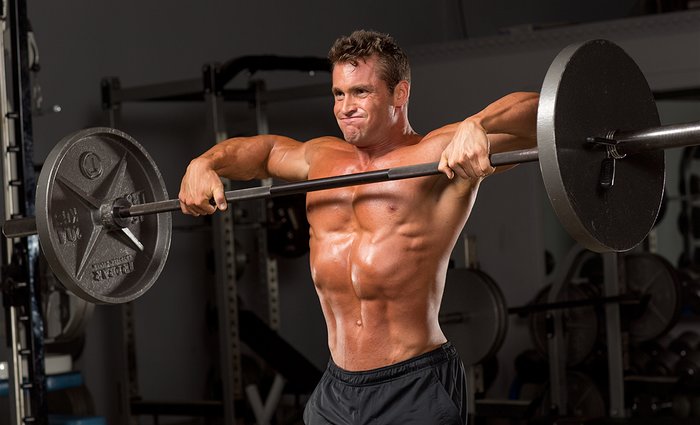The upright row is the Jan Brady of shoulder training; it's an effective but often-overlooked multijoint movement that never gets the love of its more popular sibling, the overhead press.
Part of this is because some people's shoulders just can't tolerate upright rows, but for those who can, it's a great shoulder builder you can do with any number of implements, including barbells, dumbbells, on a cable or Smith machine, and on some specialized machines.
But all free-weight versions of the movement come with the same question: How wide should your grip be? Well, that depends on your goals. So let's dig in!
Wide-Grip Upright Row
While not as popular as the closer-grip version, the wide-grip upright row places heavy emphasis on the middle delts because your upper arms move directly out to your sides in the same plane as lateral raises. It may also feel more shoulder-friendly for people who can't handle the close-grip version.

Going wide means your elbows go directly out to your sides, so the middle delts take the brunt of the load.
How wide is a wide grip? About shoulder-width apart is about right for most people, but watch the direction of your upper arms. If they're not moving directly out to your sides, adjust your hand placement as necessary to ensure you're effectively targeting the middle delts.
If you've never tried a wide grip, it may initially feel a bit awkward, so you won't be able to go as heavy as you normally do at first.
Close-Grip Upright Row
This is the version most people perform in the gym. With a close grip, your upper arms draw more forward rather than moving directly out to your sides, a sure indication the front delts are now part of the equation. This version also places a fair degree of stress on upper traps as well as the forearms, which are worked to a lesser degree in the wide-grip row.
With a close grip, your hands should be about 6-8 inches apart on a barbell. You'll be better able to balance the bar if your hands don't butt up against each other.
Which Upright Row Grip Should I Use?
Both versions target your delts, but depending on your goals and limitations, one version may be better for you than the other.
- If you're focusing on the middle delts, go for the wide grip, in which your elbows travel straight out to your sides.
- If you want more front-delt activity, choose the close-grip version.
- If you have any sort of pre-existing shoulder issue, stay away from close-grip rows, and keep your hands wide! The narrow version places undue stress on the smaller, delicate muscles of the rotator cuff as you raise your elbows above your hands.
- If recruiting your upper traps and/or forearms is critical, go narrow. Those muscles are more highly involved with the close grip.
- Don't be afraid to drop the barbell here and use dumbbells, which offer more freedom to choose a comfortable width and carry a lower risk of shoulder pain than barbells.

A close grip on the bar or plate pulls your elbows somewhat forward, now recruiting the front delts into the movement.
Learn More
Want to know how your grip affects other common exercises? Check out our guide to bench-press grip variations to learn how changing your hand placement may target different muscle fibers!

